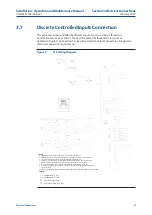
February 2022
Installation, Operation and Maintenance Manual
VCIOM-15345-EN Rev. 1
16
Installation
Section 2: Installation
2.8.3
Pre-charge Verification
Check the nitrogen pre-charge in the accumulator periodically to ensure the accumulator is
at full potential. Follow the steps below and record final readings for reference.
a.
Shut off the hydraulic power supply to the accumulator.
b.
Ensure 3-way Isolation Valve (D) is turned fully counterclockwise.
c.
Slowly open Isolation Valve (Accumulator drain) (E) and drain all the fluid
back to the reservoir.
d.
Read the pressure at the nitrogen pressure gauge (G) and compare it to
the Oil/Temperature Chart shown on the General Assembly Drawing for
the job being checked.
e.
If the pre-charge is low, add nitrogen to increase the pressure to the
requirements listed on the GA Oil/Temperature Chart. See Section 2.8.2,
Accumulator Pre-charge, if the pre-charge is high relieve pressure to equal
the GA Oil/Temperature Chart.
f.
Record Information below.
g.
With bypass valve closed, reconnect the hydraulic power supply and bring
the accumulator back up to full pressure.
h.
Check the entire nitrogen circuit for leaks using a liquid leak detector such
as Snoop (manufactured by Swagelok). As the unit is self-contained, only
a zero leak rate is acceptable. Corrective action must be taken for any
leaks found.
2.8.4 Check Thermal Compensating Device
The nitrogen pre-charge should be checked in the Thermal Compensating Device annually.
To accomplish this, use a commercially available charging kit and follow the instructions
supplied with the kit.
!
WARNING
This unit contains high-pressure hydraulic fluid and nitrogen gas. Exercise caution when
performing any type of maintenance. Wear proper safety attire and required personal
protective equipment, including safety glasses. Ensure the accumulator has been drained
of all hydraulic and nitrogen pressure before attempting any repair.
















































